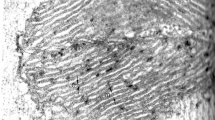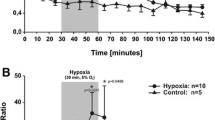Summary
Tryptophan and quinolinic acid, inhibitors of gluconeogenesis, were used to block the removal of lactate by the liver in order to investigate the involvement of the Cori cycle in oxygen debt. Five male, mongrel dogs were run on a treadmill at 4 mph with a 20 percent grade for 19 min. The mean exercise\(\dot V_{O_2 }\) was 80.67±3.11 ml/kg/min for the control tests while peak arterial lactate values ranged from 3.83 to 4.98 mM/l. When removal of lactate by the liver was blocked, oxygen debt showed a mean reduction of 44 percent. Moreover, oxygen consumption during the last minute of exercise was reduced by 11 percent.
Fasting (72 h) was used in 1 dog to prevent the accumulation of lactate during exercise. This procedure reduced oxygen debt to the same level as when the removal of lactate by the liver was blocked with tryptophan and quinolinic acid.
The data show that the lactacid as well as the alactacid component is involved in oxygen debt when lactate is being removed by the liver during the recovery period following exercise.
Similar content being viewed by others
Bibliography
Alpert, N. R., Root, W. S.: Relationship between excess respiratory metabolism and utilization of intravenously infused sodium racemic laotate and L(-) lactate. Amer. J. Physiol.177, 455–462 (1954).
Carlsten, A., Hallgren, B., Jagenburg, B., Svanborg, A., Werko, L.: Myocardial metabolism of glucose, lactic acid, amino acids, and fatty acids in healthy human individuals at rest and at different work loads. Scand. J. clin. Lab. Invest.13, 418–428 (1961).
Consolazio, C. F., Johnson, R. E., Pecora, L. J.: Physiological Measurements of Metabolic Functions in Man, p. 8. New York: McGraw-Hill 1963.
Dukes, H. H.: The Physiology of Domestic Animals, p. 638. Ithica (N.Y.): Comstock 1955.
Eggleton, M. G., Evans, C. L.: The lactic acid content of the blood after muscular conttracion under experimental conditions. J.Physiol.(Lond.)70, 269–293 (1930).
Flock, E. V., Ingle, D. J., Bollman, J. L.: Formation of lactic acid, an initial process in working muscle. J. biol. Chem.129, 99–110 (1939).
Foss, M. L., Barnard, R. J.: A vest to protect exposed chronic implants in dogs. Lab. Animal Care19, 113–114 (1969).
Foster, D. O., Lardy, H. A., Ray, P. D., Johnston, J. B.: Alteration of rat liver phosphoenolpyruvate carboxykinase activity by L-tryptophan in vivo and metals in vitro. Biochemistry6, 2120–2128 (1967).
—, Ray, P. D., Lardy, H. A.: A paradoxical in vivo effect of L-tryptophan on the phosphoenolpyruvate carboxykinase of rat liver. Biochemistry5, 563–569 (1966).
Freyschuss, U., Strandell, T.: Limb circulation during arm and leg exercise in supine position. J. appl. Physiol.23, 163–170 (1967).
Gollnick, P. D., Ianuzzo, C. D.: Colonic temperature response of rats during exercise. J. appl. Physiol.24, 747–750 (1968).
Harris, P., Bateman, M., Gloster, J.: The regional metabolism of lactate and pyruvate during exercise in patients with rheumatic heart disease. Clin. Sci.23, 545–560 (1962).
Hill, A. V., Long, C. N. H., Lupton, H.: Muscular exercise, lactic acid, and the supply and utilization of oxygen. Part I. Introduction. Proc. roy. Soc. B96, 438–444 (1924).
— — —: Muscular exercise, lactic acid, and the supply and utilization of oxygen. Part VI. The oxygen debt at the end of exercise. Proc. roy. Soc. B97, 127–137 (1924).
Huckabee, W. E.: Relationships of pyruvate and lactate during anaerobic metabolism. II. Exercise and formation of O2-debt. J. clin. Invest.37, 255–263 (1958).
Issekutz, B., Jr., Miller, H. I., Paul, P., Rodahl, K.: Effect of lactic acid on free fatty acids and glucose oxidation in dogs. Amer. J. Physiol.209, 1137–1144 (1965).
— —, Rodahl, K.: Lipid and carbohydrate metabolism during exercise. Fed. Proc.25, 1415–1420 (1966).
Jöbsis, F. F., Duffield, J. C.: Oxidative and glycolytic recovery metabolism in muscle. J. gen. Physiol.50, 1009–1047 (1967).
Jonsson, A., Madison, L. L.: The role of the kidney in blood glucose homeostasis during prolonged starvation. J. clin. Invest.47, 52a (1968).
Kayne, H. L., Alpert, N. R.: Oxygen consumption following exercise in the anesthetized dog. Amer. J. Physiol.206, 51–56 (1964).
Keul, J., Doll, E., Steim, H., Fleer, U., Reindell, H.: Über den Stoffwechsel des menschlichen Herzens. III. Der oxydative Stoffwechsel des menschlichen Herzens unter verschiedenen Arbeitsbedingungen. Pflügers Arch. ges. Physiol.282, 43–53 (1965).
Krebs, H. A.: Gluconeogenesis. Proc. roy. Soc. B159, 545–564 (1964).
—, Bennett, D. A. H., de Gasquet, P., Gascoyne, T., Yoshida, T.: Renal gluconeogenesis. The effect of diet on the gluconeogenic capacity of rat-kidneycortex slices. Biochem. J.86, 22–27 (1963).
—, Dierks, C., Gascoyne, T.: Carbohydrate synthesis from lactate in pigeonliver homogenate. Biochem. J.93, 112–121 (1964).
Levy, M. N.: Uptake of lactate and pyruvate by intact kidney of the dog. Amer. J. Physiol.202, 302–308 (1962).
Marbach, E. P., Weil, M. H.: Rapid enzymatic measurement of blood lactate and pyruvate. Clin. Chem.13, 314–325 (1967).
Margaria, R., Edwards, H. T., Dill, D. B.: The possible mechanisms of contracting and paying the oxygen debt and the role of lactic acid in muscular contraction. Amer. J. Physiol.106, 689–715 (1933).
Meyerhof, O.: Die Energieumwandlungen im Muskel. III. Kohlenhydrat- und Milchsäureumsatz im Froschmuskel. Pflügers Arch. ges. Physiol.185, 11–32 (1920).
—: Die Energieumwandlungen im Muskel. IV. Über die Milchsäurebildung in der zerschnittenen Muskulatur. Pflügers Arch. ges. Physiol.188, 114–160 (1921).
Newsholme, E. A., Grevers, W.: Control of glycolysis and gluconeogenesis in liver and kidney cortex. Vitamins Hormones20, 1–87 (1967).
Paul, P., Issekutz, B., Miller, H. I.: Interrelationship of free fatty acids and glucose metabolism in the dog. Amer. J. Physiol.211, 1313–1320 (1966).
Racker, E.: Mechanisms in Bioenergetics, p. 253. New York: Academic Press 1965.
Ray, P. D., Foster, D. O., Lardy, H. A.: Paths of carbon in gluconeogenesis and lipogenesis at the level of phosphoenolpyruvate formation. J. biol. Chem.241, 3904–3908 (1966).
Ross, B. D., Hems, R., Krebs, H. A.: The rate of gluooneogenesis from various precursors in the perfused rat liver. Biochem. J.102, 942–951 (1967).
Rowell, L. B., Brengelmann, G. L., Blackmon, J. R., Twiss, R. D., Kusumi, F.: Splanchnic blood flow and metabolism in heat-stressed man. J. appl. Physiol.24, 475–484 (1968).
—, Kraning II, K. K., Evans, T. O., Kennedy, J. W., Blackmon, J. R., Kusumi, F.: Splanchnic removal of lactate and pyruvate during prolonged exercise in man. J. appl. Physiol.21, 1773–1783 (1966).
Sacks, J., Sacks, W. C.: Carbohydrate changes during recovery from muscular contraction. Amer. J. Physiol.112, 565–572 (1935).
— —, Shaw, J. R.: Carbohydrate and phosphorus changes in prolonged muscular contractions. Amer. J. Physiol.118, 232–240 (1937).
Utter, M. P., Keech, D. B.: Pyruvate carboxylase. II. Properties. J. biol. Chem.238, 2609–2614 (1963).
Veneziale, C. M., Walter, P., Kneer, N., Lardy, H. A.: Influence of L-tryptophan and its metabolites on gluconeogenesis in the isolated, perfused liver. Biochemistry6, 2129–2138 (1967).
Young, D. R.: Effect of food deprivation on treadmill running in dogs. J. appl. Physiol.14, 1018–1022 (1959).
—, Mosher, R., Erve, P., Spector, H.: Energy metabolism and gas exchange during treadmill running in dogs. J. appl. Physiol.14, 834–838 (1959).
Author information
Authors and Affiliations
Rights and permissions
About this article
Cite this article
Barnard, R.J., Foss, M.L. & Tipton, C.M. Oxygen debt: Involvement of the Cori cycle. Int. Z. Angew. Physiol. Einschl. Arbeitsphysiol. 28, 105–119 (1970). https://doi.org/10.1007/BF00698050
Received:
Issue Date:
DOI: https://doi.org/10.1007/BF00698050




